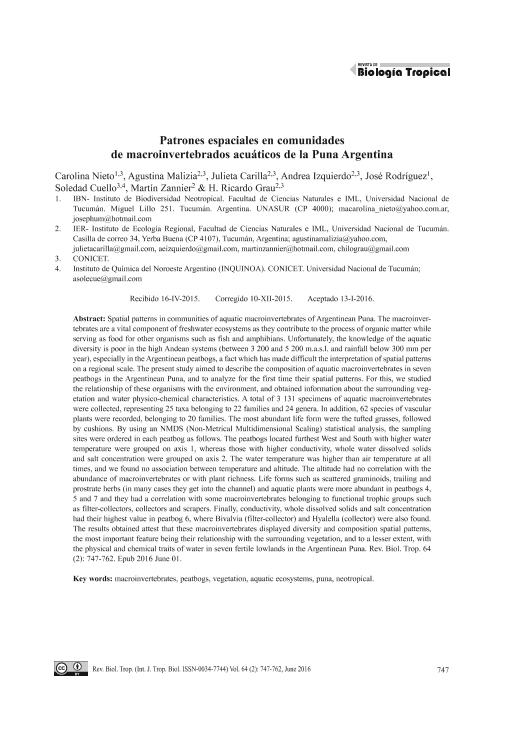Artículo
Patrones espaciales en comunidades de macroinvertebrados acuáticos de la Puna Argentina
Título:
Spatial patterns in communities of aquatic macroinvertebrates of Argentinean Puna
Nieto Peñalver, María Carolina ; Malizia, Agustina
; Malizia, Agustina ; Carilla, Julieta
; Carilla, Julieta ; Izquierdo, Andrea Elisa
; Izquierdo, Andrea Elisa ; Rodríguez, José Sebastián; Cuello, Ana Soledad
; Rodríguez, José Sebastián; Cuello, Ana Soledad ; Zannier, Martin
; Zannier, Martin ; Grau, Hector Ricardo
; Grau, Hector Ricardo
 ; Malizia, Agustina
; Malizia, Agustina ; Carilla, Julieta
; Carilla, Julieta ; Izquierdo, Andrea Elisa
; Izquierdo, Andrea Elisa ; Rodríguez, José Sebastián; Cuello, Ana Soledad
; Rodríguez, José Sebastián; Cuello, Ana Soledad ; Zannier, Martin
; Zannier, Martin ; Grau, Hector Ricardo
; Grau, Hector Ricardo
Fecha de publicación:
06/2016
Editorial:
Revista de Biología Tropical
Revista:
Revista de Biología Tropical
ISSN:
0034-7744
Idioma:
Español
Tipo de recurso:
Artículo publicado
Clasificación temática:
Resumen
The macroinvertebrates are a vital component of freshwater ecosystems as they contribute to the process of organic matter while serving as food for other organisms such as fish and amphibians. Unfortunately, the knowledge of the aquatic diversity is poor in the high Andean systems (between 3 200 and 5 200 m.a.s.l. and rainfall below 300 mm per year), especially in the Argentinean peatbogs, a fact which has made difficult the interpretation of spatial patterns on a regional scale. The present study aimed to describe the composition of aquatic macroinvertebrates in seven peatbogs in the Argentinean Puna, and to analyze for the first time their spatial patterns. For this, we studied the relationship of these organisms with the environment, and obtained information about the surrounding vegetation and water physico-chemical characteristics. A total of 3 131 specimens of aquatic macroinvertebrates were collected, representing 25 taxa belonging to 22 families and 24 genera. In addition, 62 species of vascular plants were recorded, belonging to 20 families. The most abundant life form were the tufted grasses, followed by cushions. By using an NMDS (Non-Metrical Multidimensional Scaling) statistical analysis, the sampling sites were ordered in each peatbog as follows. The peatbogs located furthest West and South with higher water temperature were grouped on axis 1, whereas those with higher conductivity, whole water dissolved solids and salt concentration were grouped on axis 2. The water temperature was higher than air temperature at all times, and we found no association between temperature and altitude. The altitude had no correlation with the abundance of macroinvertebrates or with plant richness. Life forms such as scattered graminoids, trailing and prostrate herbs (in many cases they get into the channel) and aquatic plants were more abundant in peatbogs 4, 5 and 7 and they had a correlation with some macroinvertebrates belonging to functional trophic groups such as filter-collectors, collectors and scrapers. Finally, conductivity, whole dissolved solids and salt concentration had their highest value in peatbog 6, where Bivalvia (filter-collector) and Hyalella (collector) were also found. The results obtained attest that these macroinvertebrates displayed diversity and composition spatial patterns, the most important feature being their relationship with the surrounding vegetation, and to a lesser extent, with the physical and chemical traits of water in seven fertile lowlands in the Argentinean Puna.
Palabras clave:
Aquatic Ecosystems
,
Macroinvertebrates
,
Neotropical
,
Peatbogs
,
Puna
,
Vegetation
Archivos asociados
Licencia
Identificadores
Colecciones
Articulos(CCT - NOA SUR)
Articulos de CTRO.CIENTIFICO TECNOL.CONICET - NOA SUR
Articulos de CTRO.CIENTIFICO TECNOL.CONICET - NOA SUR
Articulos(IBN)
Articulos de INSTITUTO DE BIODIVERSIDAD NEOTROPICAL
Articulos de INSTITUTO DE BIODIVERSIDAD NEOTROPICAL
Citación
Nieto Peñalver, María Carolina; Malizia, Agustina; Carilla, Julieta; Izquierdo, Andrea Elisa; Rodríguez, José Sebastián; et al.; Patrones espaciales en comunidades de macroinvertebrados acuáticos de la Puna Argentina; Revista de Biología Tropical; Revista de Biología Tropical; 64; 2; 6-2016; 747-762
Compartir
Altmétricas



